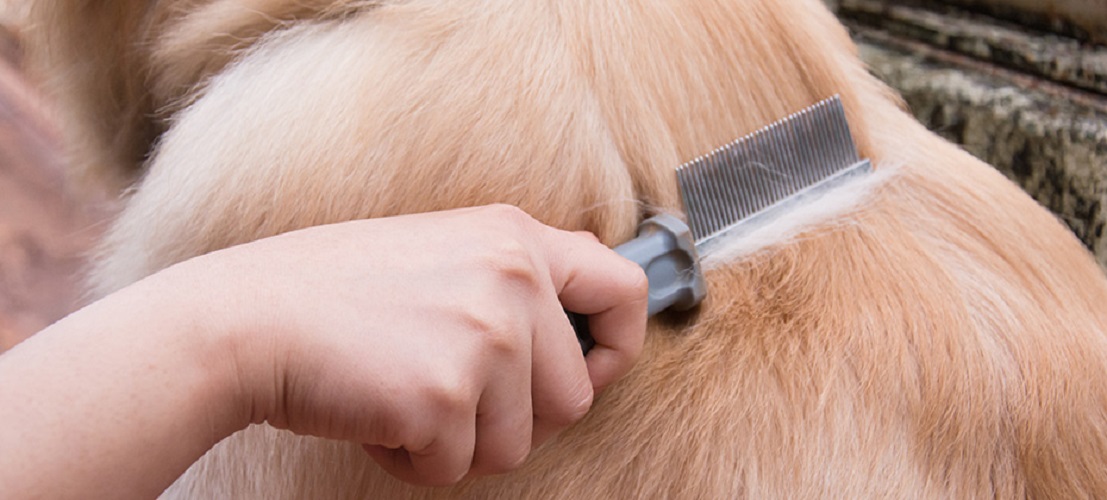
Having a hirsute booster is truly a joy, simply it also comes with responsibilities, one of which is maintaining their overall health and well-being. Just like humans, dogs tin suffers from various scrape issues that put up cause uncomfortableness and distress. While fleas are commonly noted to be a nuisance for our canine companions, did you know that flea combing can actually serve you detect unusual skin problems your furry supporter may be facing? In this article, we will research how flea combing not only helps in getting rid of pesky fleas but also serves as an operational symptomatic joyride for detecting other scrape issues in dogs. So, grab a transfuse of coffee, sit back, and let’s dive into this informative and upbeat discussion!
Before we dig out into the benefits of flea combing, let’s quickly understand why fleas are a green concern among dog owners. Fleas are small, wingless insects that feed on the blood of animals, including our beloved canines. These tiny critters tin cause vast discomfort to our furry friends, with symptoms including excessive scratching, biting, and even out hair loss. Additionally, fleas can lead to more serious health issues much as anemia and infections. Therefore, it’s crucial to address flea infestations promptly.
Now, you English hawthorn wonder how flea combing tin serve you detect other skin problems in your dog. Well, the answer lies in the meticulous work on of comb your dog’s fur with a specialized flea comb. Flea combs have closely spaced teeth, premeditated to trap and transfer fleas from your dog’s coat. During this process, you not only eliminate the fleas but also get the opportunity to closely examine your dog’s skin, thereby enabling you to spot any other underlying issues that Crataegus oxycantha have gone unremarked otherwise.
Let’s explore more or less common skin problems that can be perceived through flea combing:
1.Allergies: Allergies are rather common in dogs and can certify in various forms. Flea saliva is a common allergen, causing hypersensitivity reaction reactions known as flea allergy undefined (FAD). Through flea combing, you may mark redness, inflammation, and rashes on your dog’s skin, indicating an hypersensitivity reaction reaction. Identifying and addressing these allergies promptly put up greatly improve your dog’s timbre of life.
2.Mites and Ticks: While flea combing is in the first place focused on fleas, it also gives you an opportunity to undefined for strange parasites care mites and ticks. Mites can cause conditions such as mange, leadership to intense skin pique and pilus loss. Ticks, on the other hand, can channelize dangerous diseases to your furry friend. By thoroughly combing your dog’s fur, you can spot these parasites and assay appropriate treatment.
3.Dry Skin: Just like humans, dogs can suffer from dry skin, especially during careful seasons or in dry climates. Flea combing allows you to observe any daftness or dry patches on your dog’s skin, indicating the need for moisturizing treatments or changes in dietary habits. Ensuring proper hydration and using moisturizing products specifically designed for dogs tin serve alleviate dry scrape issues.
4.Infections: Flea bites can sometimes lead to secondary bacterial infections. By intimately examining your dog’s scrape during flea combing, you may spot signs of infection much as redness, pus, or foul odor. Early detection and prompt treatment of these infections can prevent them from spread and causation further complications.
5.Lumps and Bumps: While combing your dog’s fur, you may come across any unusual lumps or bumps on their skin. These can be kind growths, cysts, or even early signs of more unplayful conditions much as tumors. Regular flea combing allows you to monitor your dog’s skin and detect any new developments, enabling timely veterinary intervention if needed.
In conclusion, maintaining your dog’s scrape health is material for their overall well-being. Flea combing offers a dual benefit of getting rid of fleas and helping you detect other scrape issues in your cuspid companion. By carefully examining their skin piece combing, you can identify allergies, hot spots, mites, ticks, dry out skin, infections, and even out lumps or bumps. Remember to take the right flea comb, create a steady environment, be gentle and patient, and seek veterinary surgeon advice if necessary. With regular flea combing and appropriate preventative measures, you put up ascertain that your dog’s scrape stays healthy and release from any discomfort. So, happy flea combing and here’s to a cheerful and vibrant living for your haired friend!

